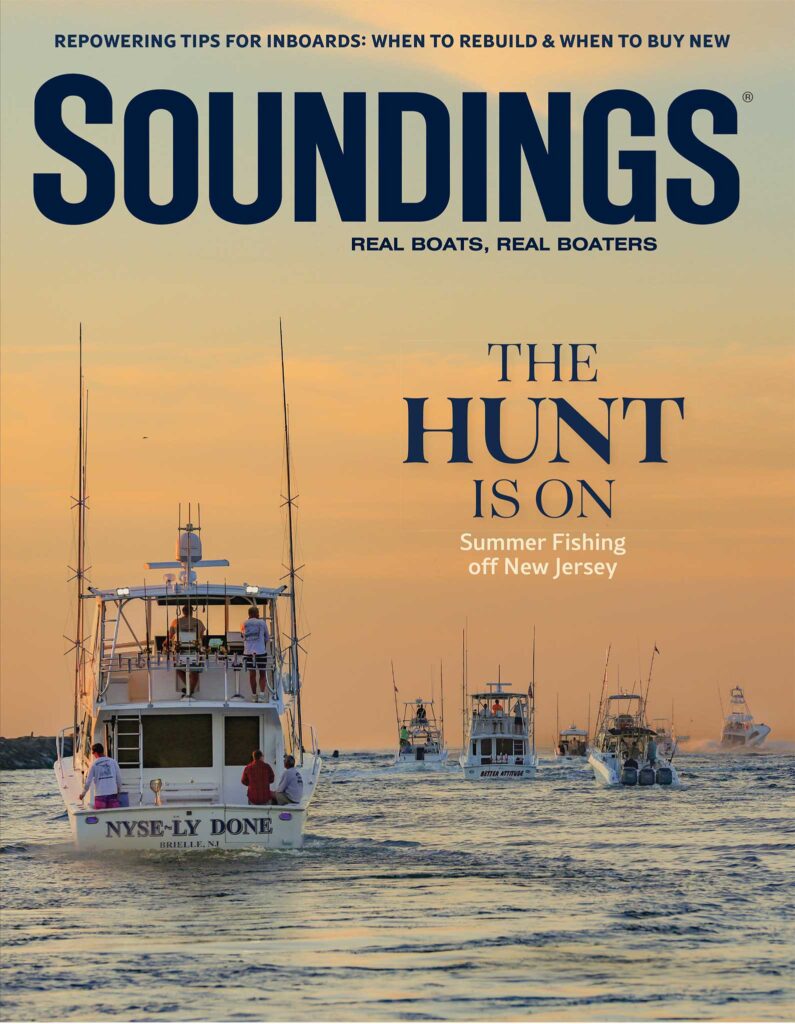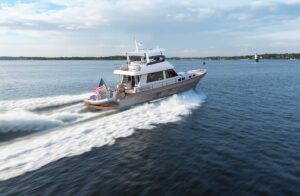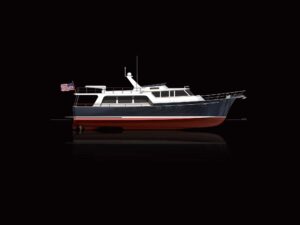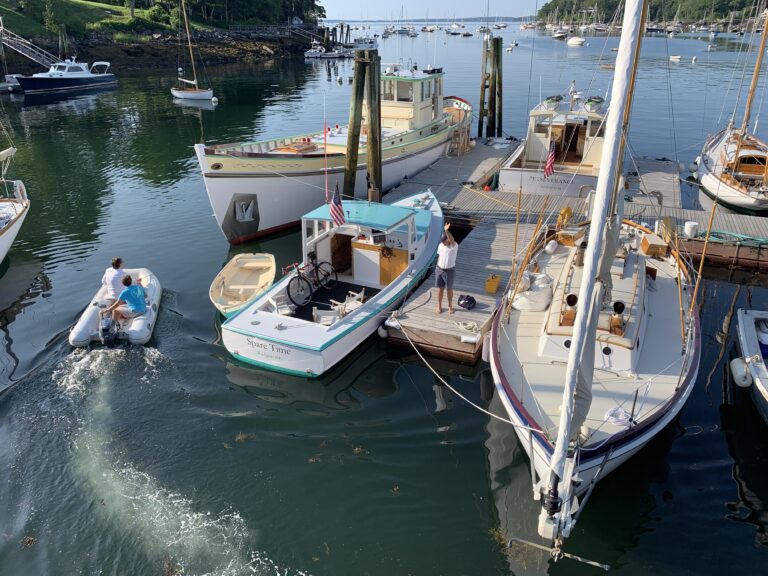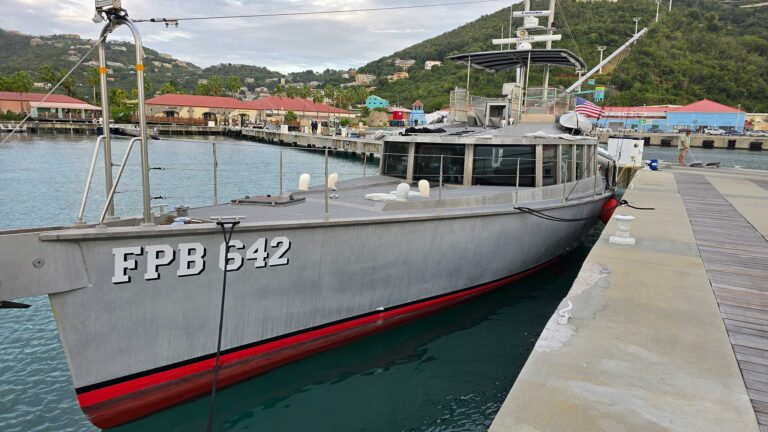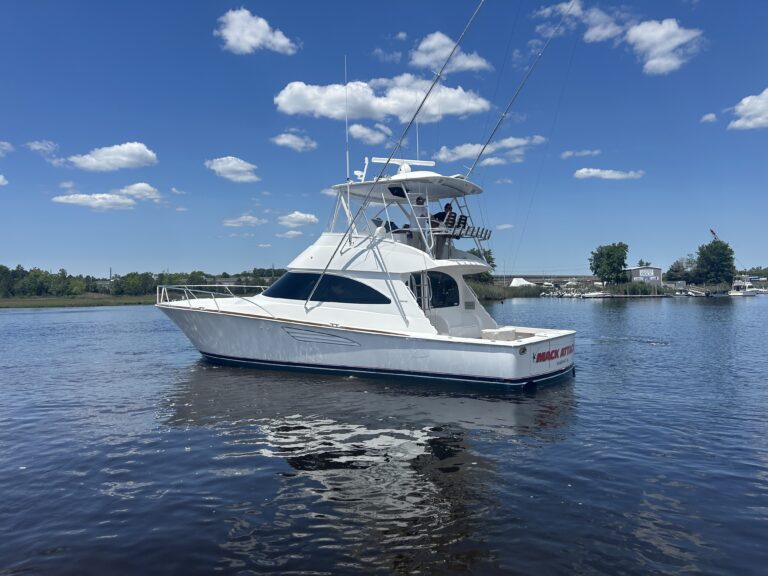Center consoles have been growing in popularity and size ever since Boston Whaler launched what is considered to be the first boat of this kind. The 16-foot Nauset—introduced in 1960 and the brainchild of company founder Dick Fisher and chief designer Bob Dougherty—was little more than an oversized dinghy, but with a difference. It sported a hand-built mahogany console and bench seat mounted in the center of the boat, with space to walk around both sides from bow to stern. It was simple, but in some ways it started a revolution in boat design.
Early center console models were basic fish boats with spartan layouts. The features that set them apart were the 360 degrees of walkable deck space and low-cost outboard power. These boats were relatively inexpensive to purchase, run and maintain. They were a blue-collar fisherman’s dream come true, simple boats for simpler times. Today’s center consoles are anything but, with propulsion, technology and amenities that would have been hard to imagine back in the 1960s. One of the first center console boats to push the LOA envelope was the Ocean Master 31, designed in 1974 by Mark Hauptner, an outboard dealer by trade. That boat was an outlier for many years, until the early 1990s when more production center consoles over 30 feet started to appear on the water. The space race was on as a new generation of boaters embraced the design, which was no longer just for fishing.
Today, while there are center console boats well over 50 feet, perhaps the most active LOA segment is the 30- to 40-foot range. There are a number of new boats from major builders in this size category, and they are making a splash with features that push the design envelope.
BOSTON WHALER 360 OUTRAGE

Although Whaler is credited with the creation of the first production center console design, it’s entry into the large center console market began with the 27-foot Outrage in 2001, shortly after Brunswick Corporation acquired the company. According to Wil Rogers, director of large boat sales and a 20-year veteran with Whaler, the boat featured a 24-degree hull that gave it solid offshore credentials and it was available with more comfort features. “It seemed like a pretty big center console at the time, but customer demand drove the development of even larger Outrage models,” Rogers says. “Today, the line includes boats from 23 to 42 feet with four over the 30-foot mark, so I guess you could say that’s where the market is focused.”
In February, Whaler introduced the 360 Outrage, which showcases the kind of technological innovation that makes the boat stand out in a competitive segment. “The 360 is new from the hull up,” Rogers says. “It is an integration of cutting-edge technologies in a great running boat. Our goal was to make the complex simple and create a comfortable environment for passengers. We feel it raises the bar for center console boats.”

The 360 has attractive lines, is thoughtfully laid out and can be customized to be as plush as the owner desires. Smart design features include the centerline step and hardtop hatch that make it possible to access the tower if you opt for one. Whaler’s “point of storage” concept assures that there are storage areas close to where they are needed. Creature comforts include seating options and a more organized cabin and sleeping space.
“I’m most proud of our new Fathom Inverter-based electrical system that utilizes lithium-ion batteries capable of operating everything onboard for extended periods without shore power or a generator,” says Rogers. He encourages boat buyers to also look at the 360’s digital switching technology and simplified GUI (graphical user interface) that allows the operator to track and control every electrical component and system on the boat through the Simrad MFDs at the helm. “This is the future of boating, a totally seamless experience from a package that is intuitive and user-friendly.”
SOLACE 32 CS
While the Solace brand might not be familiar to everyone—this builder launched its first boat in 2019—the company’s CEO could be. Stephen Dougherty is the son of Bob Dougherty, the man who helped design the Boston Whaler Nauset 16. Bob oversaw Whaler’s move from Rockland, Massachusetts, to a new facility in Edgewater, Florida, where Stephen started his career working on the production line. Bob went on to start Edgewater Boats, and later father and son created Everglades Boats.

Todd Albrecht, president of Solace, says the increased interest in center consoles in the mid-30-foot range is driven by several factors. “Yes, there are boat owners moving up from smaller craft, but our research shows a significant increase in owners moving down in size,” he says. “They have a lot of experience and have come to realize that their family’s needs can be fulfilled with a center console under 40 feet. These boats have the amenities, speed, seaworthiness and range to get to places like the Bahamas, along with other advantages. They fit easily on backyard boat lifts or in smaller slips, and can be rack-stored at more reasonable prices. These boats require fewer engines, burn less fuel and are easier to maintain than larger boats.”
The newest center console from Solace is the 32 CS, a design that was
inspired by the work of outboard manufacturers like Yamaha and Mercury. Their high-horsepower motors make it possible for builders to produce boats with strong performance when pushed by just two engines, rather than three or four. “Our 32 can run 60 mph with a pair of 300-hp outboards, the most popular engine size on the market today,” says Albrecht.
The outboards power a twin-step hull with chine rails on the after running surface. The rails, says Albrecht, make the boat track extremely well. It’s also less prone to slip when put through hard-over turns. Chine rails also push down spray, which comes up from the sides of many step hulls. Passengers won’t get soaked sitting in the transom seats on this 32. The Solace is built with high-tech composites, including Innerga hybrid carbon/glass cloth, which are resin-infused to create a strong structure with less weight. That makes for better performance with fewer ponies.
INVINCIBLE 33 CATAMARAN
Bill Cordes is the vice president of sales for Invincible Boats and has been with the company since it launched its first model in 2007, the 36 Open Fisherman. That 36-foot monohull center console was one of the first to incorporate Michael Peters’ Stepped-V Ventilated Tunnel (SVVT) bottom. It was a game-changer for performance and handling. Cordes says boats in the 30- to 40-foot range continue to represent the heart of the center console market. Invincible offers seven models in this size range: three monohulls and four power catamarans.

“What made these large center consoles possible was the introduction of outboards capable of pushing big loads at high speeds. Today, the Yamaha 425 and Mercury 600 are locomotives that are paving the way for even longer center consoles that can reach speeds in excess of 60 mph.”
Invincible’s latest introduction is the 33 Catamaran, a dedicated offshore fishing boat. Cordes says cats represent an exciting segment of the center console market and are attracting boaters who are ready to leave their monohull models. One of the features that makes the Invincible distinctive, he says, is its Morrelli & Melvin-designed semi-asymmetric hull, which conquers the unsettling handling characteristics once associated with some power cats.

“Our cats have incredible handling, even for the novice boater,” he says. “They push the boundaries of offshore performance to a new level. They are fast and eat up rough seas while giving the customer more deck space than a comparably sized mono-hull because they carry the broad beam all the way to the bow.”
Creature comforts include three seats at the helm, a mezzanine-style bench at the console and lounge seating forward. The 33 is a twin-engine boat that can handle up to 900 hp. Says Cordes, “Performance is breathtaking and when the weather turns sour, this boat will get you there and back safely.”
REGULATOR 37 EVOLUTION
Since 1988, the year the first 26-foot Regulator center console was introduced, the company has hung its hat on the design and stuck with it. Marine architect Lou Codega designed a deep-V hull that gave it what became known as the “Regulator ride,” and it has been hailed as one of the finest sea boats, the one by which others are judged. The company eventually sold more than 1,500 units before the 26 was retired in favor of new 25- and 28-foot models.

“We listen closely to what our owners say. They told us they wanted bigger boats so we responded to their request with new models,” says Regulator President Joan Maxwell. “All Regulators are built on Lou’s remarkable hulls, but our new boats offer more comfort and family-oriented amenities to go with the fishing features. We remain a customer-driven company, and our new 37 Evolution is the result of that feedback.”
The 37 is the most refined and technologically advanced boat the builder has offered to date. “We don’t build disposable boats,” says David Chubb, Regulator’s in-house naval architect. “Our boats are heavier and stronger because history has shown they will be on the water for many decades. The 37 has a taller sheer to provide more interior space, more room below for accommodations, and advanced mechanical and electrical systems.”
Interesting features include an aft-facing mezzanine seat that rises on gas rams to reveal a dry locker where breakers, batteries, A/C compressors and a Seakeeper 5 are housed. The cabin is spacious and has an enclosed head and galley. For anglers there are oversized fishboxes with macerators, a massive transom livewell, a hardtop festooned with rod holders and a hullside door for bringing big fish aboard. Three Yamaha XTO 425-hp outboards ride on a bracket and link to a digital switching system that allows the operator to control all the systems on the boat from a single screen. With that propulsion, the boat can do 60 mph. Trim is controlled with Zipwake.
“Our proprietary My Helm software provides a graphic interface for all the systems on a single screen,” says Chubb. “During the programming phase we instituted a three-click rule, which means you can access and control any system with no more than three clicks on the touch screen. We devoted a lot of resources to creating this system, which integrates the Yamaha keyless ignition seamlessly. You can hit a button on your key fob when approaching the boat and remotely power up. The goal of all this development work is to make the boat as user- friendly as possible.”
FOUNTAIN 32NX
In the high-performance center console segment, one company set the mark for others to follow—Fountain Powerboats. Company founder Reggie Fountain was pulled into the center console segment by king mackerel fishermen who were competing in tournaments in the mid-1980s. The builder’s first model was a 29-footer, but it was the introduction of the 34- and 38-foot boats that really set the trail on fire. Nothing was faster or better equipped for that type of fishing. Fountain was early to develop stepped hulls powered by triple and then quad outboards.

Jeff Harris became Fountain’s COO under the ownership of Iconic Marine in 2019, but his roots with the company go back to rolling fiberglass on race boats in 1980. He was involved in the development of the center consoles and all the trial and error that went into getting the hulls just right. Remember, this was before computation fluid dynamics software. Back then, you built it, tried it, tweaked it and tried it again until you got it right.
“I remember running some of the other brands of center consoles on the tournament circuit and they were just horrible,” Harris says. “Small, slow, poorly equipped and short on range. We started with the 29, then added an integrated outboard platform that bumped it up to 31 feet. With the introduction of the 34 and then 38 in 2002, tournament fishermen got everything they wanted in a wide-beam, high-performance, well-equipped boat. The popularity of those models has never waned. What changed was the demand for more plush center consoles from our non-fishing customers. Today, the trend in customization is stronger than ever, and it’s evident in our new 32NX.”
Introduced at the Miami Boat Show, the 32 can be ordered in multiple configurations. “Some customers want an open bow, multiple live wells and the latest electronics for tournament fishing, while others want plush seating, extra storage, an incredible stereo system and a graphics package,” Harris says. “To fill all those needs the 32 is what I call a component boat. We can build it to your specifications from an extensive list of options. It is the most customizable boat we’ve offered.”
The 32 NX is also a screamer, with engine packages that can provide a range of performance, from kind of mild to really wild. The base package is a pair of Mercury 300M outboards that push the twin-step hull to a top speed of 61 mph. Optional propulsion includes triple 450R engines that make for a blistering 89 mph at WOT. If you are running at that pace offshore, the fish may not have a chance.
This article was originally published in the May 2022 issue.

